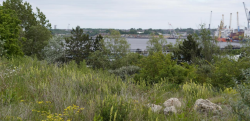This is the next of our series of Site Spotlights, where we shine a spotlight on some of the great biodiversity work that is being carried out at CEMEX sites across the country. This time we are visiting Jarrow Wharf in South Tyneside.
On the bank of the River Tyne the team are making good progress with their Biodiversity Management Plan (BMP).
During the past two years the site has monitored wildflowers, butterflies and other types of wildlife whilst also ensuring that nesting seabirds remain undisturbed. Crucial is the action site has undertaken on monitoring and removal of invasive weeds and identification of non-native plants to controlled and removed as required. The site doesn’t use herbicide or insecticide to protect nearby waterways and help preserve invertebrates.
Much of this area is known as an Open Mosaic Habitat; a valuable habitat that can develop on previous industrial / brownfield sites. As a former shipyard and aggregate recycling facility, the site supports a diverse range of pollinators, which in turn assists the recovery of biodiversity more generally in the local area – which some people would find surprising given its former use!
It’s rich in wildflower species and home to native bumblebee species, butterflies and daytime moths you would expect to see in much more established meadows. The team have seen notable butterfly species such as Dingy Skipper and Wall Brown. Both species have been reported through the National Biodiversity Network and a list of butterfly species spotted on site has been sent to the NGO Butterfly Conservation. The site is also home to nine species of native bumblebee which not only supports biodiversity at the site but also helps establish a local nature network to expand into surrounding areas.
Being close to the northeast coast, sea buckthorn scrub, has established in some areas on site. This is used by nesting songbirds during spring and summer and the seeds provide a food source for the birds well into the winter. The team are delighted to see Herring Gulls, which have been in decline nationally, successfully nesting every year. They ensure that nesting seabirds remain undisturbed as part of their BMP. The red listed Kittiwake and protected Arctic Terns have also been spotted on site as they nest on the nearby Tyne Bridge.
Well done to all those at the site and in the UK Sustainability team who are working hard to enhance Jarrow Wharf’s biodiversity.
If you’d like to find out more about the BAP at Jarrow Wharf, or have any other questions about BMPs, please contact Jenny Oldroyd at the RSPB or Sean Cassidy.
